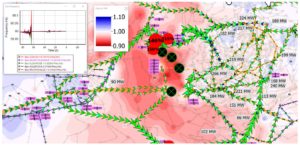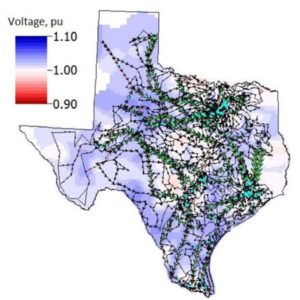Dr. Overbye and his research staff/students are involved in several innovative research activities in the evolving field of power systems. In this section, however a few of the current and interesting research works are presented. A more comprehensive list of recent works can be found here, and his google scholar profile.
Large-Scale Electric System Research Center at Texas A&M – Description & Associated Research Activities
The vast interconnected-ness of the bulk power system introduces complexities in the dynamics and operations of the power grid. Long- and short-term planning, even in the midst of confidentiality issues, remains critical in creating a proactive grid management plan. A large-scale electric system research center at Texas A&M (“Center”), configured to provide deep insights into performance of the entire electric system, provides a testbed for the basis of planning research in addressing evolving grid challenges. This work describes systems and equipment at the Center used to support on-going research. The work also describes select recent research to better inform the reader of the Center’s overall capabilities in grid modernization, grid resiliency, sustainability, GMD impacts, human factors, visualization and synthetic grids.

User Interaction and Component Integration
More details of the research environment associated with the Center (also known as the TAMU/CIR Control Room Lab are available here.
 Synthetic power systems that imitate functional and statistical characteristics of the actual grid have been developed to promote researchers’ access to public system models. Developing time series to represent different operating conditions of these synthetic systems will expand the potential of synthetic power systems applications. This work proposes a methodology to create synthetic time series of bus-level load using publicly available data. Comprehensive validation metrics are provided to assure that the quality of synthetic time series data is sufficiently realistic. More details are available here
Synthetic power systems that imitate functional and statistical characteristics of the actual grid have been developed to promote researchers’ access to public system models. Developing time series to represent different operating conditions of these synthetic systems will expand the potential of synthetic power systems applications. This work proposes a methodology to create synthetic time series of bus-level load using publicly available data. Comprehensive validation metrics are provided to assure that the quality of synthetic time series data is sufficiently realistic. More details are available here
A GIC Estimator for Electric Grid Monitoring During Geomagnetic Disturbances
 Electric power system state estimation is a vital part of real-time monitoring and management for power grid operations and control. With increased interest in the effects of geomagnetically induced currents (GICs) and effective mitigation strategies therein, similar tools that provide situational awareness during GMD events are increasingly necessary. Therefore, a GIC estimator is developed by relating the known system parameters and measurements to the current “GIC state,” from which the GIC currents in transformers can be quickly calculated. Due to the linearity of GIC relationships, the estimator solves quickly and efficiently. The proposed methods are tested on a small example and a synthetic Texas 2000 bus scenario. These studies show the effectiveness of a GIC estimator to provide situational awareness for real-time operations, as well as sensitivity to measurement uncertainty and availability. More details are available here
Electric power system state estimation is a vital part of real-time monitoring and management for power grid operations and control. With increased interest in the effects of geomagnetically induced currents (GICs) and effective mitigation strategies therein, similar tools that provide situational awareness during GMD events are increasingly necessary. Therefore, a GIC estimator is developed by relating the known system parameters and measurements to the current “GIC state,” from which the GIC currents in transformers can be quickly calculated. Due to the linearity of GIC relationships, the estimator solves quickly and efficiently. The proposed methods are tested on a small example and a synthetic Texas 2000 bus scenario. These studies show the effectiveness of a GIC estimator to provide situational awareness for real-time operations, as well as sensitivity to measurement uncertainty and availability. More details are available here
Mosaic Packing to Visualize Large-Scale Electric Grid Data
 For large power systems, a continual challenge is to display wide-area data in a way that maximizes human users’ situational awareness. This work describes a new visualization technique that draws a mosaic of colored tiles to represent multiple data fields for electric grid objects, arranged to preserve geographic context. The key problem in creating these diagrams is packing the tiles onto the display space, minimizing the total displacement while forbidding overlaps. This work formulates that problem and presents a horizontal-packing algorithm which is able to produce a feasible, quality solution at an interactive time scale. Illustrative examples are shown for using mosaics to monitor wide-area generator status and dispatch, bus voltages, and line and transformer limits. Mosaics can be customized in numerous ways to show different aspects of the system state, providing for human users a simultaneous sense of the wide-area summary, regional trends, and prominent outliers. More details are available here
For large power systems, a continual challenge is to display wide-area data in a way that maximizes human users’ situational awareness. This work describes a new visualization technique that draws a mosaic of colored tiles to represent multiple data fields for electric grid objects, arranged to preserve geographic context. The key problem in creating these diagrams is packing the tiles onto the display space, minimizing the total displacement while forbidding overlaps. This work formulates that problem and presents a horizontal-packing algorithm which is able to produce a feasible, quality solution at an interactive time scale. Illustrative examples are shown for using mosaics to monitor wide-area generator status and dispatch, bus voltages, and line and transformer limits. Mosaics can be customized in numerous ways to show different aspects of the system state, providing for human users a simultaneous sense of the wide-area summary, regional trends, and prominent outliers. More details are available here
Wide-Area Electric Grid Visualization Using Pseudo-Geographic Mosaic Displays
This work introduces a new technique for wide-area visualization of information about electric power grids known as a pseudo-geographic mosaic displays (PGMDs). The PGMD approach uses dynamically created geographic data view (GDV) objects to show information about the attributes of different electric grid objects, and then arranges them on the screen to maximize the used display space. The paper presents the PGMD algorithm and then discusses design approaches to maximize their usability. Results are presented for several large-scale electric grids. More details are available here
Educational Applications of Large Synthetic Power Grids
 This work describes the use of large electric grids in university electric power system courses. Since much actual power system information is not publicly available, the application of public domain synthetic grids developed by the authors is presented including a 2000-bus grid. Discussion of the educational applications utilized in a senior level class are given for power flow analysis and sensitivity, economic dispatch, contingency analysis, optimal power flow (OPF), security-constrained OPF, transient stability, and real-time dynamic operations. In each of these, the application of the large synthetic grids give students insights and experience with cases closer to actual power systems in complexity and size. More details are available here
This work describes the use of large electric grids in university electric power system courses. Since much actual power system information is not publicly available, the application of public domain synthetic grids developed by the authors is presented including a 2000-bus grid. Discussion of the educational applications utilized in a senior level class are given for power flow analysis and sensitivity, economic dispatch, contingency analysis, optimal power flow (OPF), security-constrained OPF, transient stability, and real-time dynamic operations. In each of these, the application of the large synthetic grids give students insights and experience with cases closer to actual power systems in complexity and size. More details are available here
Grid Structural Characteristics as Validation Criteria for Synthetic Networks
 This work presents a methodology and set of validation criteria for the systematic creation of synthetic power system test cases. The synthesized grids do not correspond to any real grid and are, thus, free from confidentiality requirements. The cases are built to match statistical characteristics found in actual power
This work presents a methodology and set of validation criteria for the systematic creation of synthetic power system test cases. The synthesized grids do not correspond to any real grid and are, thus, free from confidentiality requirements. The cases are built to match statistical characteristics found in actual power
grids. First, substations are geographically placed on a selected territory, synthesized from public information about the underlying population and generation plants. A clustering technique is employed, which ensures the synthetic substations meet realistic proportions of load and generation, among other constraints. Next, a network of transmission lines is added. This paper describes several structural statistics to be used in characterizing real power system networks, including connectivity, Delaunay triangulation overlap, dc power flow analysis, and line intersection rate. The paper presents a methodology to generate synthetic line topologies with realistic parameters that satisfy these criteria. Then, the test cases can be augmented with additional complexities to build large, realistic cases. The methodology is illustrated in building a 2000 bus public test case that meets the criteria specified. More details are available here



